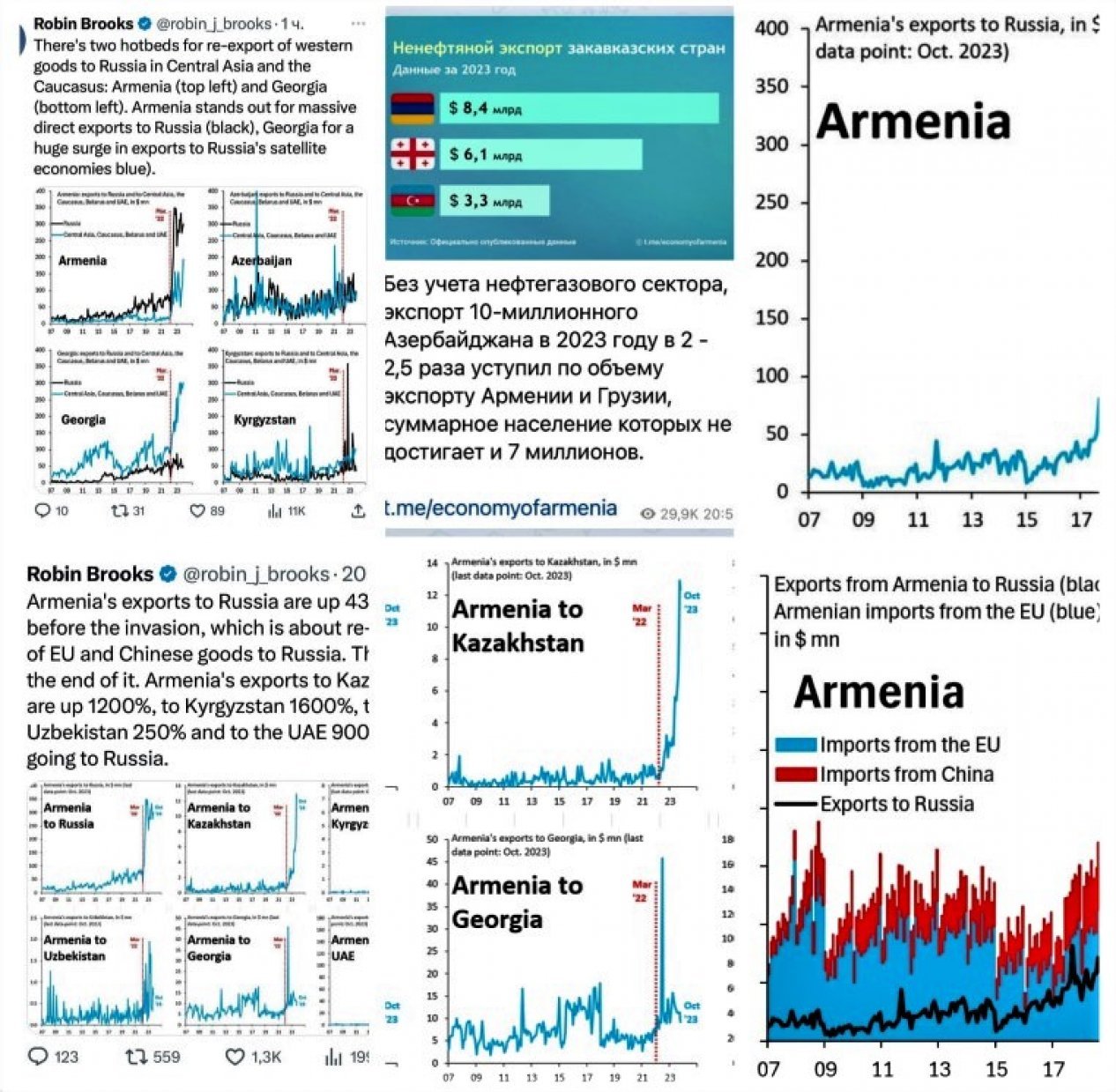
Information and infographics have spread in social networks about Armenia's foreign trade turnover in 2023, specifically its export capacity, alleging that it grew to $8.4 billion, and that it took the first place in the South Caucasus in terms of non-oil exports. According to the published data, Armenia's net export in 2023 was $8.4 billion, Georgia's export was $6.1 billion, and Azerbaijan's non-oil export was $3.3 billion. source
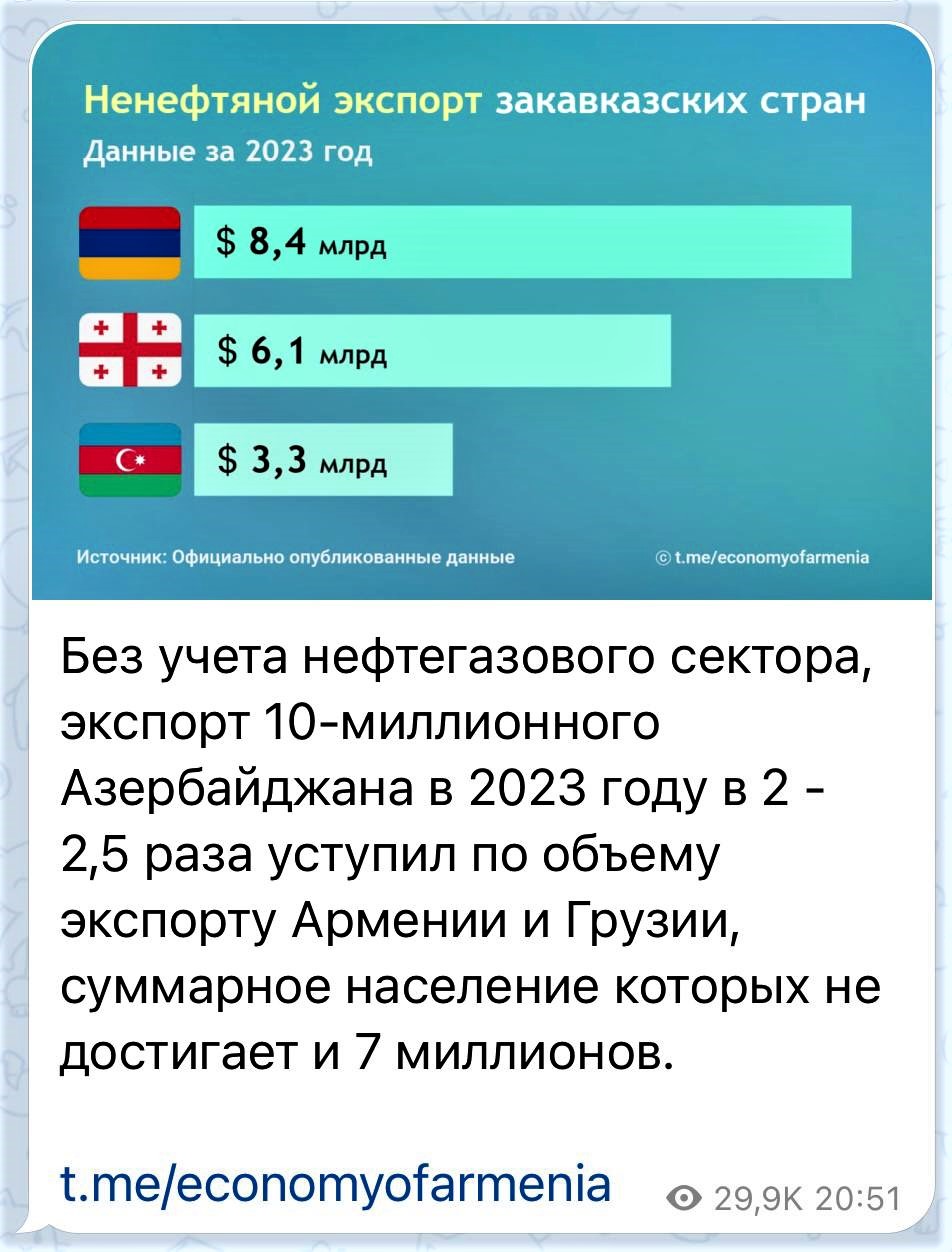
Faktyoxla Lab. has investigated whether these figures published by Armenia are true.
The mentioned information is posted with reference to the statistics of the economic institutions of Armenia. According to the National Statistical Committee of Armenia, the volume of foreign trade turnover in 2023 increased by 46% compared to 2022 and amounted to $20.7 billion. This is while $8.4 billion of the turnover of goods are exports, $12.3 billion are imports. A trade deficit of about $5 billion was registered.
In 2022, the volume of exports of this country amounted to $5.3 billion. reference
According to the information of the statistical agency, Armenia's export grew by $3.1 billion or 55.3% in the last year. Analyzing the numbers, it becomes clear that Russia has traditionally taken the first place in Armenia's commodity turnover. The volume of goods exchange with Russia amounted to $7.3 billion in 2023. This is a 43.3% increase over 2022. Armenia's exports to Russia amounted to $3.5 billion. reference
Along with the Eurasian Economic Union (EEU) and CIS countries, Armenia's trade volume with Asia and the European Union (EU) has also increased. The volume of foreign trade turnover with EU countries increased by 17.1% and reached $2.6 billion. The volume of goods imported from European countries has increased sharply. Also, the United Arab Emirates (UAE) came to the fore in trade, the exchange of goods between the two countries reached $2.3 billion, the increase was 3.9 times in one year.
As for the structure of the goods that Armenia "sells" to foreign countries, the main export goods are precious and semi-precious stones, gold jewelry, precious metals and products made from them worth $3.2 billion (a 3.2-fold increase compared to 2022), machinery, the value of equipment and machinery worth $1.3 billion (an increase of 79.6%), mining and food industry products worth $1.8 billion (an increase of almost 2 times), and the remaining $2 billion accounted for communications, electrotechnical equipment, processing, tobacco products, beverages, food products and other household goods. source
But what is the reality, do the mentioned statistics and figures reflect the real export potential?
There are enough facts and arguments that confirm that the information spread by the National Statistical Committee of Armenia and groups engaged in economic agitation on social media are fake and fabricated. First of all, let's pay attention to the opinions of Robin Brooks, the world-famous financial researcher, chief strategist of the Goldman Sachs economic analysis center and chief economist of the Institute of International Finance, who exposed these fake foreign trade statistics.
Mr. Brooks' solid facts and well-founded arguments exposing the lies and fraud of Armenian experts on his social media accounts, as well as in reputable economic publications, caused great resonance. Brooks reveals the nature of fake exports of $8.4 billion with a simple explanation and says that those figures are just imaginary export growth. The economist notes that the export figures of the Armenian "Statcom" are actually trade statistics of goods transported from other regions and countries, including the EU to Russia via Armenia, and this has nothing to do with Armenia's net exports. This propaganda of the Armenians is just commercial fiction.

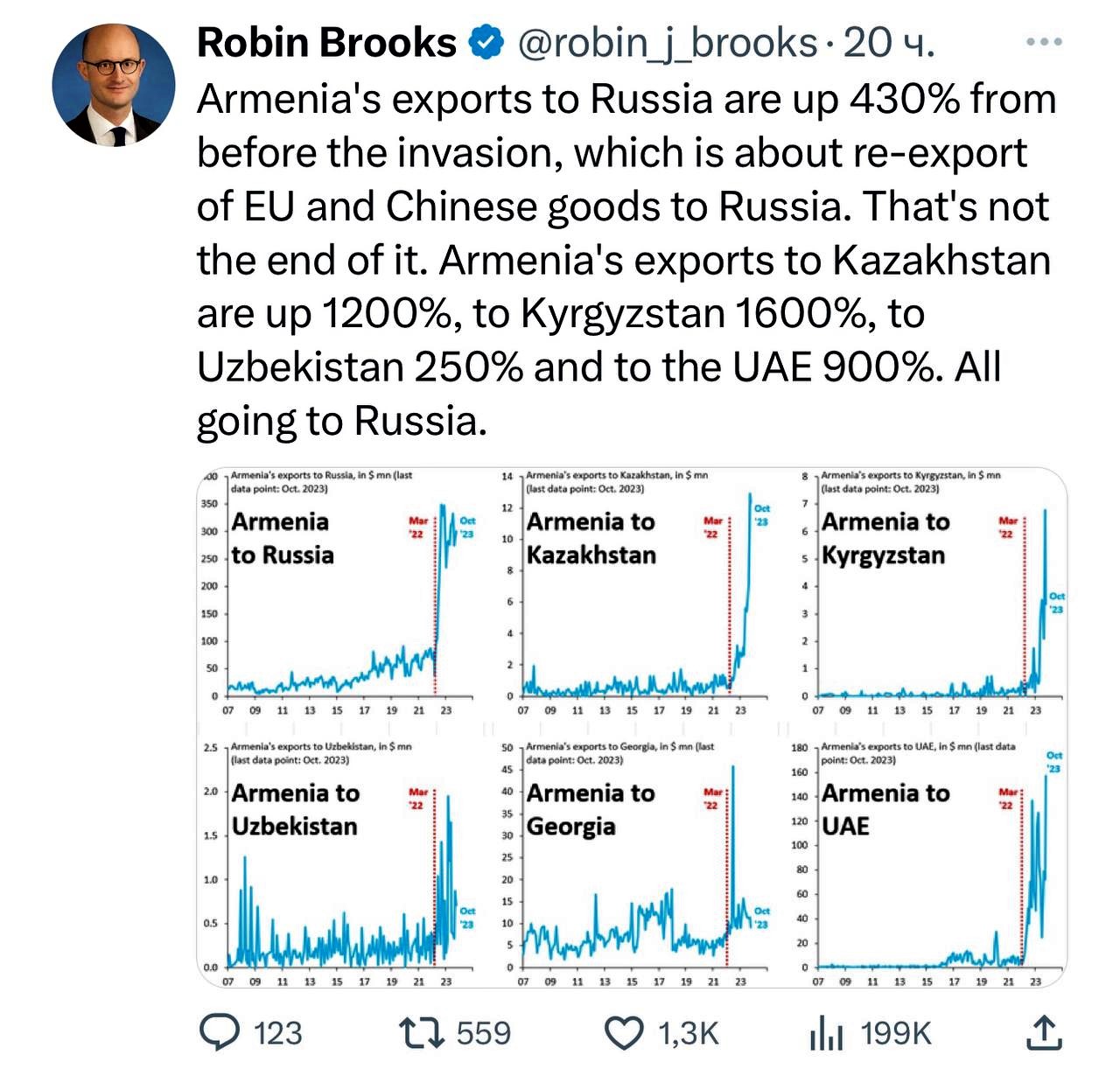
Brooks notes that Armenia's exports to Russia have increased by 430% compared to the pre-occupation period, which means the re-export of EU and Chinese goods to Russia. The work does not end there, Armenia's exports to Kazakhstan, Kyrgyzstan, Uzbekistan and the UAE have also increased by record numbers in the last year. reference
As can be seen from the infographic, goods in transit via the EU (blue) and China (red) to Russia (black) have increased sharply every month since March 2022 - after the start of the war with Ukraine - and exceeded 430 percent at the end of 2023.
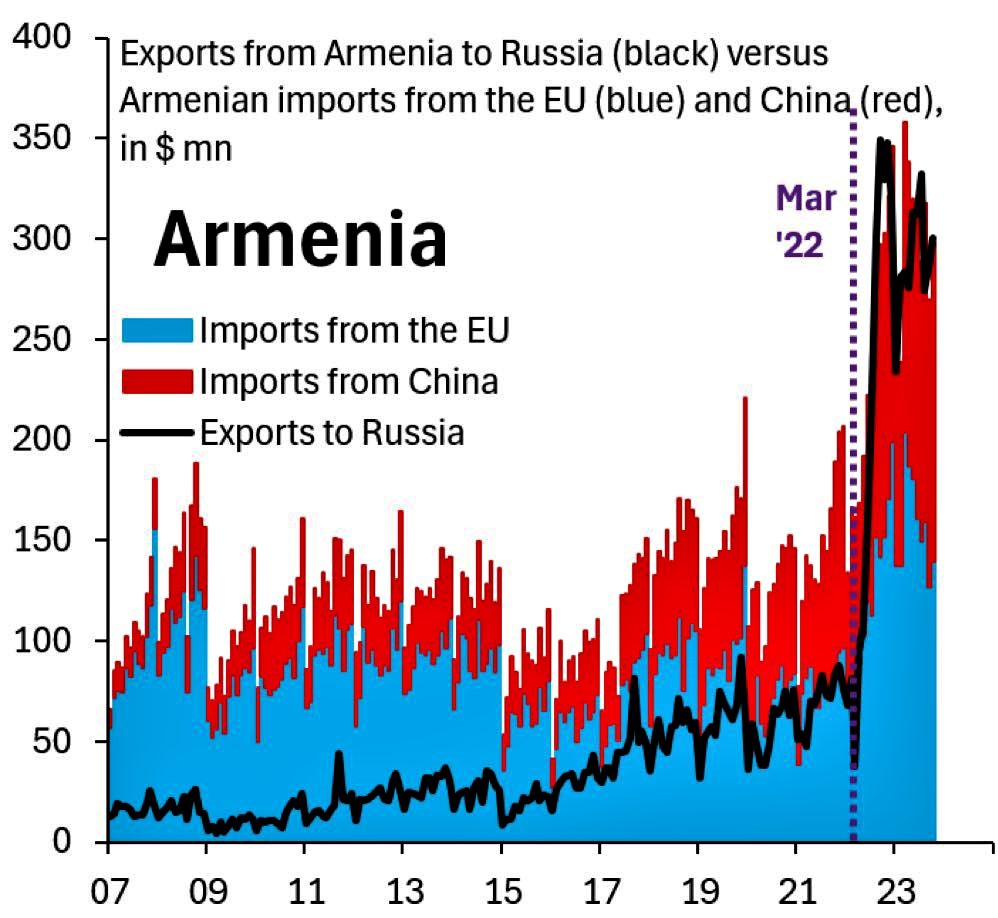
Since these export goods pass through Armenia, which is a secret door, the Armenian customs registers them as national exports, and those goods included in the export nomenclature of the country's "Statcom" have nothing to do with Armenia. (source)
Apparently, precious metals, electrotechnical equipment, machines and mechanisms, mining industry and other industrial products, which Armenia considers to be exports, are net re-exports, that is, goods belonging to other countries are delivered to another country through Armenia, it is a re-export scheme. The main part of re-export is directly to Russia. Thus, approximately 40 percent of Armenia's re-export of $8.4 billion or $3.5 billion falls to Russia. The sharp increase in the volume of trade turnover between Russia and Armenia in the last three years is a clear proof of this. In 2021, the volume of goods exchange between the two countries amounted to $2.6 billion. Russia accounted for $1.8 billion of turnover, and the remaining $800 million was exported by Armenia.
In 2022, the trade turnover between Russia and Armenia amounted to $5.3 billion, which is twice as much as in 2021. The volume of exports from Armenia to Russia increased four times from $850 million in the previous year to $2.5 billion.
Exports grew faster in the second half of 2022, which coincided with the most severe periods of sanctions against Russia. So, if in the first half of that year, exports to Russia amounted to approximately $546 million, in the second half this figure increased three times and exceeded $1.8 billion. Armenia's export of mechanical and electronic equipment has reached a record level, and there has been an increase of about 10 times. The export value of that equipment increased from $60 million to $695 million. (source)
In 2023, the volume of mutual goods turnover between Armenia and Russia further increased and reached $7.306 billion. Exports from Armenia to Russia increased by 39% and amounted to $3.418 billion. In other words, exports increased by $1 billion again in the last year. reference
The fact is that in addition to Armenia's exports to Russia, the trade turnover with the United Arab Emirates (UAE), China, Belarus, and Central Asian countries has also increased sharply. The volume of trade turnover with the UAE alone increased four times, from $580 billion to $2.298 billion. The increase in the exchange of goods was entirely due to the export from Armenia to the UAE. reference
The four-fold increase in Armenia's exports to the UAE is due to Russia. Due to the sanctions, Russia delivered a number of industrial goods, including military products, to the Arab region through Armenia-Iran transit. Also, the delivery of gold and precious metals from the Central Asian region to the Arab region through processing in Armenia is a part of this scheme. source
The reality is that the Armenian government does not have the real potential that it is trying to impose on the world economic community, such as $8.4 billion exports.
This country does not have the resources and resources to produce and send goods, materials, raw materials and equipment worth approximately $3.5 billion to the Russian Federation. Especially in the last two years, the export capacity and the economic potential behind it, which would ensure a 430 percent growth of exports, have not been created. In order for Armenia's exports to Russia to increase 4.5 times, its domestic industry had to grow at least 450 percent in the last two years.
How much has Armenian industry developed in the last two years?
According to the National Statistical Committee of Armenia, in 2022, the total industrial production in Armenia, including food products, increased by 7.9%. The increase was mainly not due to mining, but due to the production of fruit and vegetable canning, as well as industries serving construction. Production from metal mines (copper, molybdenum, etc.) decreased by 4.7%. The production of metallurgical products and metal products increased by more than 15 percent, which is due to the increase in the import of components of these products. reference
As one can see, the industry, which is the source of Armenia's exports in 2022, has increased by only 14 percent.
In 2023, the production of industrial products increased by only 4.1% compared to 2022. The volume of production in the mining industry decreased by 6.4%. A 6.7% increase was recorded in the processing industry, which is one of the sectors with the largest share in the structure of the industry. According to the summary of the rate of increase and decrease in other areas, the total industrial capacity grew by 4.1 percent last year.
Thus, in 2022-2023, the production volumes of industrial goods, which are the source of Armenia's exports, increased by 18 percent. This means that the export potential and capacity of this country can increase only by 18-20 percent. In such a case, there is no doubt that the increase of exports by 300-400 percent in the last two years, especially the increase of exports to Russia by more than 430 percent, is not based on the strength of national exports, but directly on re-exports, as we mentioned above.

Economists of this country also admit that Armenia's foreign trade is based on re-export. According to Eliza Matevosyan, an employee of the "Orbeli" analytical center, the growth of exports in Armenia has been observed more after the Russian-Ukrainian war, which leads to an increase in the range of both re-exports and the main exported goods groups.
Expert economist Ashot Khurshudyan believes that after the sanctions imposed on Russia, re-exports through Armenia continuously increase exports. In particular, the increase in the export of precious and semi-precious stones, precious metals and products made from them, as well as electronic equipment, belonging to different countries is more noticeable. (reference)
Western countries also sell products from Armenia to Russia
The point is that the growth of Armenia's exports along with its imports is not based on the demand of the national economy. Europe, Asia, the Middle East and other regional countries fear the sanctions of the US and the European Union against Russia and deliver their goods not directly, but through Armenia. The increase of exports from EU countries to Armenia in the last two years confirms this. In 2022, Armenia's trade with the European Union increased by 43.8% compared to the previous year and exceeded $2 billion from $1.2 billion. Armenia bought a large amount of industrial equipment and machine technologies from European countries. source
In 2023, the volume of imports from EU countries to Armenia increased by 27.1% and amounted to $2.249 billion. Germany ($563.6 million, an increase of 23.2%), Italy ($321.4 million, an increase of 31.1%) and the Netherlands ($185.9 million, an increase of 35.9%) are in the top three by the volume of imports. The main goods imported from the EU countries to Armenia were machines, equipment and mechanisms, precious metals and products made from them, land and air vehicles, mining industry goods, and industrial products. Especially in the last two years, a sharp increase in Armenia's import of various heavy equipment and electronic products from Germany has been recorded.
It goes without saying that he imported those goods not for the internal demand of Armenia, but to be transferred to Russia. Because Armenia does not need imports worth $12.3 billion recorded last year. This amount of imported goods is huge for a country with a population of 2.9 million. The volume of imports per person is $4,246 per year or $354 per month. In Armenia, which is a poor and weak country, importing goods worth $354 per person and $1,416 per month for a family of four is absolutely unbelievable. This once again confirms that the imported goods and equipment are not for the population of Armenia, but for export to a third country. In particular, the continuous transportation of products from the European Union, which Armenia does not need, shows that imports serve the purpose of re-exports.
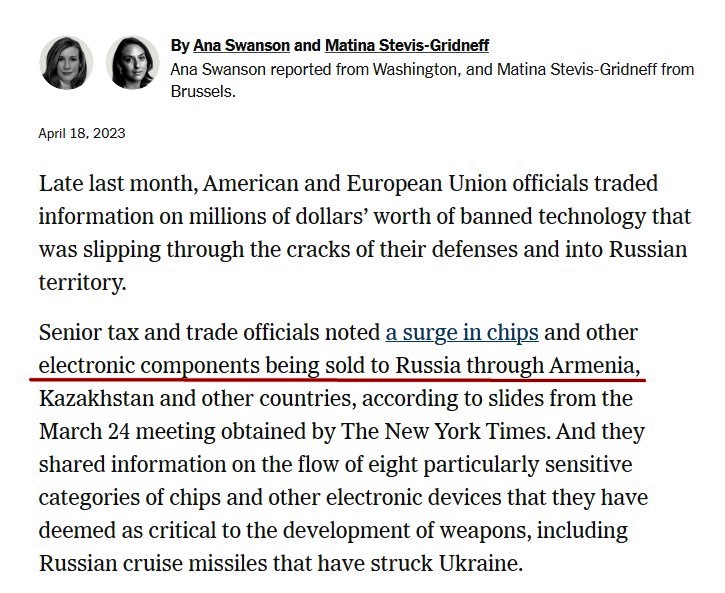
Last year, The New York Times published an article expressing its concern over Armenia's re-export of a number of electrotechnical equipment purchased from the United States and Europe to Russia. A document marked with the seal of the US Bureau of Industry and Security states that in 2022, Armenia imported 515 percent more chips and processors from the United States and 212 percent more from the European Union than in 2022, and then exported 97 percent of those products to Russia.
As a result of its investigation, the Bild publication also discovered a secret scheme for the delivery of German industrial products to Russia through the CIS countries. According to the information of the Federal statistical body, the publication notes that after the imposition of sanctions on Russia, exports from Germany to Central Asia and Armenia have more than doubled. Most of the exported products are of re-export origin and are delivered to Russia. (source)
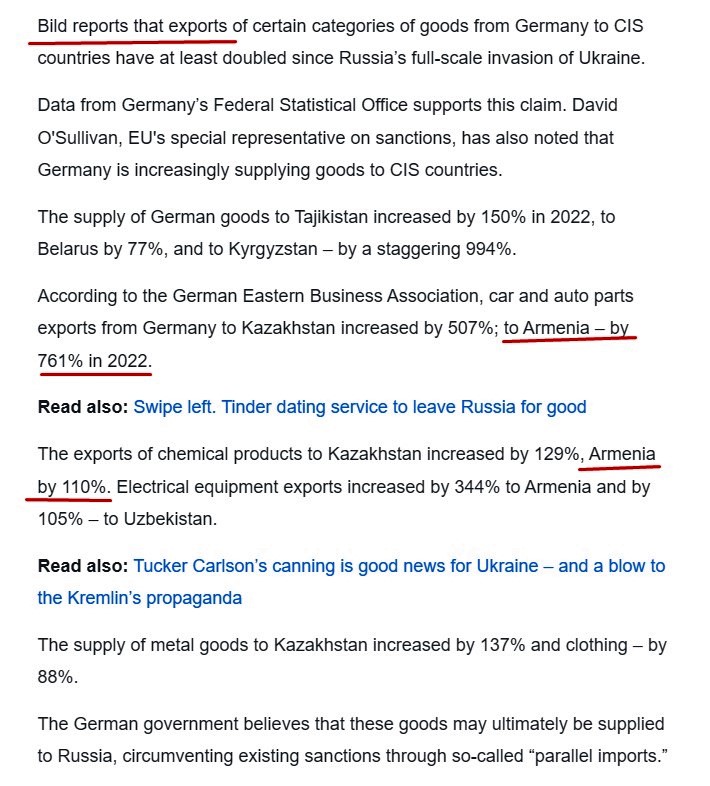
Armenia's secret trading schemes to Russia, Belarus, Iran and other regions, avoiding sanctions, are also reflected in the reports of the United States. According to the report of the Office of Foreign Assets Control (OFAC) of the US Treasury Department, Armenia plays the role of a bridge in the transfer of goods from other countries to Russia. In particular, electrical engineering and radio technologies used in Russia's military industry, jeeps, and other such products are transported through Armenia. In the basic materials of the US Department of Justice, it was confirmed that the goods transported with fake invoices were delivered to Russia via Armenia and Cyprus. source

The inclusion of Armenia-owned Taco LLC (the Yerevan supplier of China's Sinno Electronics. Co.) for the supply of radio-automation equipment to Russia confirms what has been said. source
The vast majority of semiconductors, microcircuits, and electronic equipment exported by Armenia to Russia are not produced in this country, that is, they are brought from other geographies. The note of the US Treasury Department shows that Armenia's Milur Electronics LLC and Taco LLC sold microchips, electronic and telecommunication equipment to the Russian company Radioavtomatika. source
The US Treasury Department's Bureau of Industry and Security, the Treasury Department's Office of Foreign Assets Control, and the Department of Justice have included Armenia's name in the clandestine shipment scheme in the tripartite memorandum on the participation of third countries in cases of evasion of sanctions and export controls related to Russia and Belarus. source
In general, the names of more than 20 Armenian import-export companies have been included in OFAC's sanctions list.
The reality is that products and equipment belonging to other countries are transported to neighboring countries through Yerevan, and Armenia marks this as its export and writes it down as official statistics. There is no real potential that the Armenian government is trying to impose on the world economic community, such as $8.4 billion worth of exports. This country does not have the resources to produce and send goods, materials, raw materials and equipment worth approximately $3.5 billion to the Russian Federation. Especially in the last two years, the export capacity and the economic potential behind it, which would ensure a 430 percent growth of exports, have not been created.
Conclusion:
- The figures published that Armenia has a net export of $8.4 billion do not reflect the real economic picture and are manipulative in nature;
- The export figures of "Statcom" of Armenia are actually trade statistics of goods transported from other regions and countries, including the EU to Russia via Armenia, and this has nothing to do with Armenia's net exports;
- Precious metals, electrotechnical equipment, machines and mechanisms, mining industry and other industrial products, which Armenia considers to be exports, are net re-exports, that is, goods belonging to other countries are delivered to another country through Armenia, it is a re-export scheme;
- Armenia's export and trade-customs statistics are not based on real trade-economic sources, but are fake export statistics exaggerated due to the registration of goods belonging to other countries;
- Armenia re-exports products from China, India, Iran, Central Asia and the European Union to Russia and other countries;
- The vast majority of goods declared as industrial and precious metals in Armenia's exports are actually electrotechnical means, jeeps and electrical devices used for military industrial purposes;
- Armenia is an active participant in secret transit by sending industrial goods purchased from the EU and various countries to Russia under the name of its demand, openly violating the sanctions of the US and the European Union against Russia.




















